UKIYO specialises in aged beef, prepared in-house, a rarity in humid, space-starved Hong Kong. Dry-ageing meat for several weeks breaks down the connective tissues, tenderising the beef while giving it a deeper, more concentrated taste. While beef is UKIYO’s speciality, Chef Arthur – who was mentored by a Japanese-trained Hong Kong teppanyaki veteran – plans to have a rotating seasonal menu focusing on Japanese ingredients with French influences.
The decor – dark panelled wood, granite countertops, teppanyaki grill – is straight out of the late 1980s, when shoulder pads and three-hour power lunches were still a thing. The front dining area is small, perhaps able to seat 20 or so, and there’s a private room near the back that can fit a few more. By the looks of UKIYO, it seems to promise a luxurious anachronistic take on the past.
To begin, one of the most enjoyable parts of the meal wasn’t even on the menu. As a tea lover, I feel that the rich, earthy hojicha deserves some special recognition.
We were served a nine-course lunch menu ($520), a decadent meal that took us from land to sea to the limits of our stomach linings.
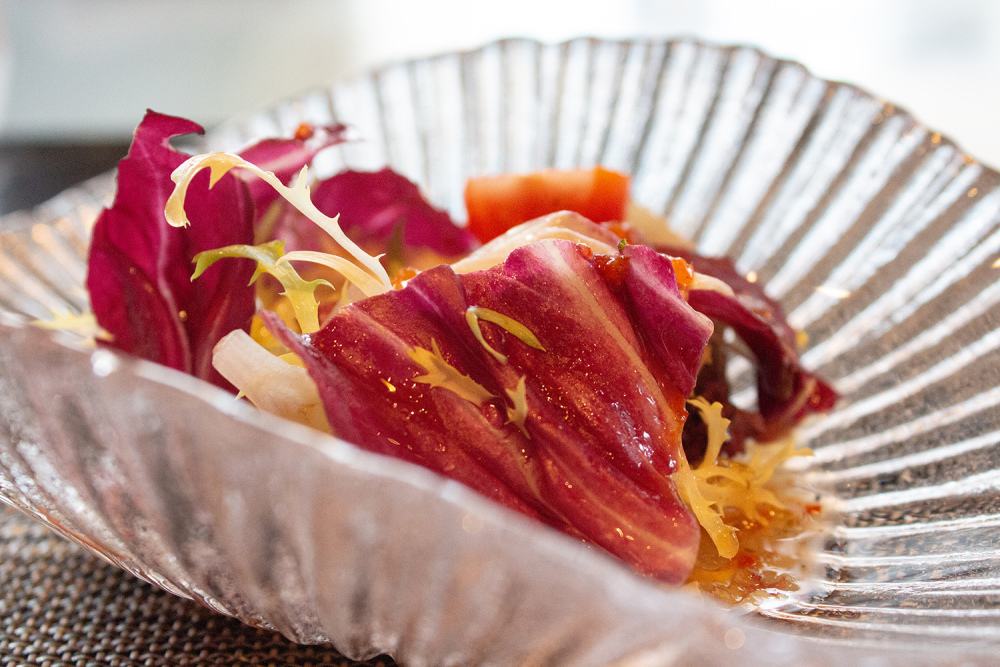
The simple green salad came with a pitcher of tomato vinaigrette, which was refreshing and tangy, almost like a slow-cooked tomato jam. Half the fun of going to a teppanyaki restaurant is watching the chef prepare your food right in front of you, though the results can sometimes be gimmicky. At UKIYO, the chef blended almost seamlessly into the background. He courteously answered our questions, but it was clear that at UKIYO it’s more about the flavours than being flash and fancy.
While the lobster, firmly fleshed specimens from the South China Sea, cooked, changing from a mottled blue to its signature red, the waitstaff quietly replaced our empty salad bowls with cute owl cups, whose heads revealed a creamy steamed egg custard – chawanmushi – which was made even more decadent with bits of crab and pork.
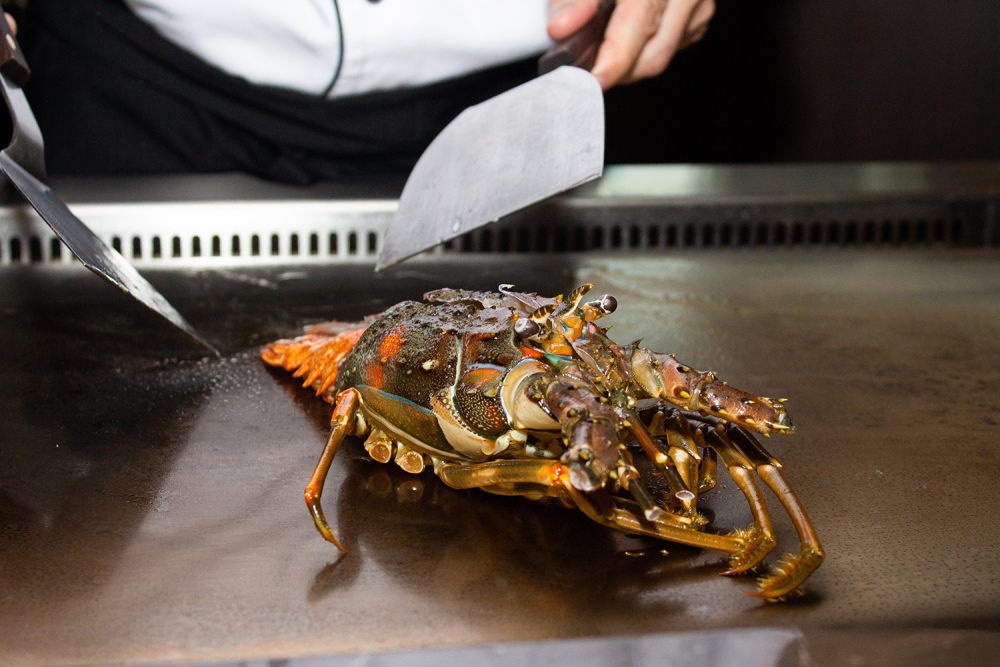
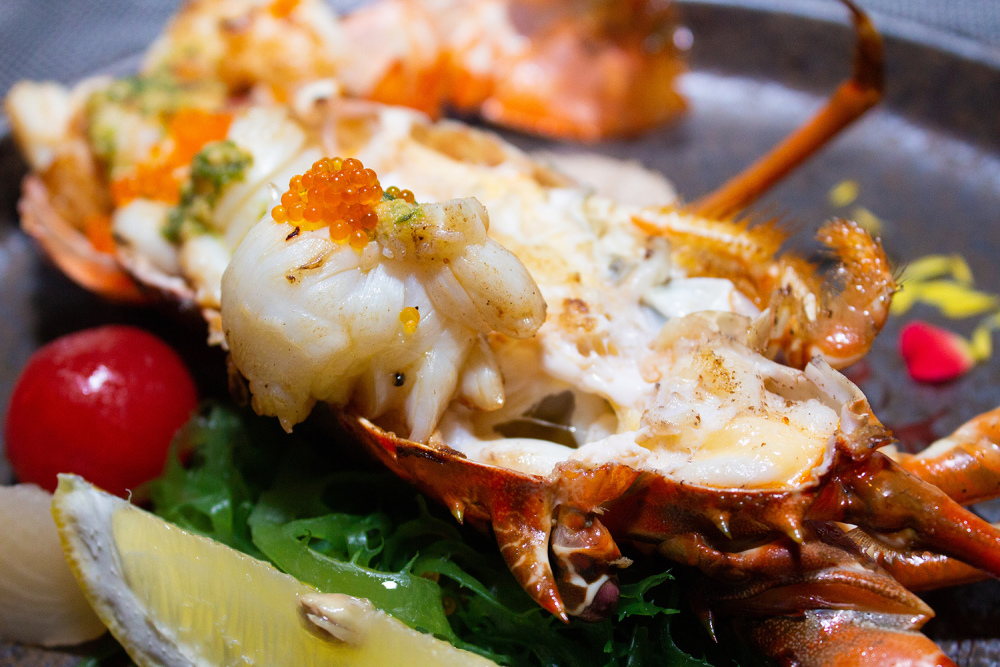
Garnished with roe and edible flowers, the lobster was stunning in presentation. But taste-wise, it was a bit stiff – something about the texture and smell reminded me of a shiny new leather shoe, which may have had something to do with it not being in season.
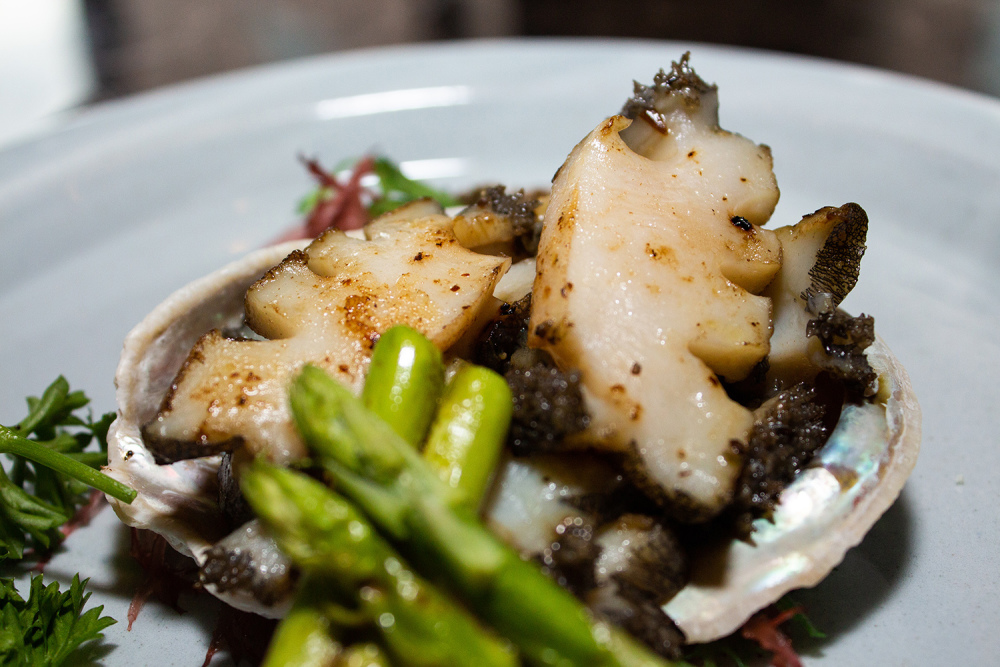
The South African abalone that followed, however, was everything I wanted its predecessor to be: succulent and savoury, without any hint of rubberiness. Accompanied by grilled baby asparagus, this one was of our favourite courses. It seemed almost a shame that the star attraction – the beef – was to follow, since the abalone clearly seemed to be the dark horse.

Except the aged US Prime rib-eye wasn’t a let-down. We were expecting good beef at a steakhouse, but it was clear here how the additional process of ageing the beef gives UKIYO that extra edge compared to other teppanyaki spots.
We were recommended to dip the thin-cut slices, which were delicate and rolled in wasabi, in the sesame and soy sauce and to pair the thick-cut slices, which were marbled, tender and rich, with fresh wasabi, a pepper blend and fried garlic. For a lighter and more flavourful taste, the thin-cut beef is my pick, but if you’re looking for a full-on, umami-packed piece of steak, the thick-cut beef is ideal (especially paired with the wasabi).
The courses that followed were a bit of blur after the flavour explosion of the beef. The fried rice, despite being Chef Arthur’s self-proclaimed best dish, was a bit too heavy for me to finish, although the pickled burdock served alongside it provided a welcome tang. The stir-fried vegetables seemed to be an extension of the rice rather than a new dish and, although I was craving something green, did not give me the satisfying freshness I was seeking.
The miso soup, however, was divine. Lightly sweet and hearty without being cloying, UKIYO’s rendition was one of the best I’ve ever had and a welcome change of pace from the heavier grilled flavours.
Dessert was a single slice of chilled melon: simple, crisp and just perfect, the most melon-tasting melon of all melons, ending the meal on a refreshing note.
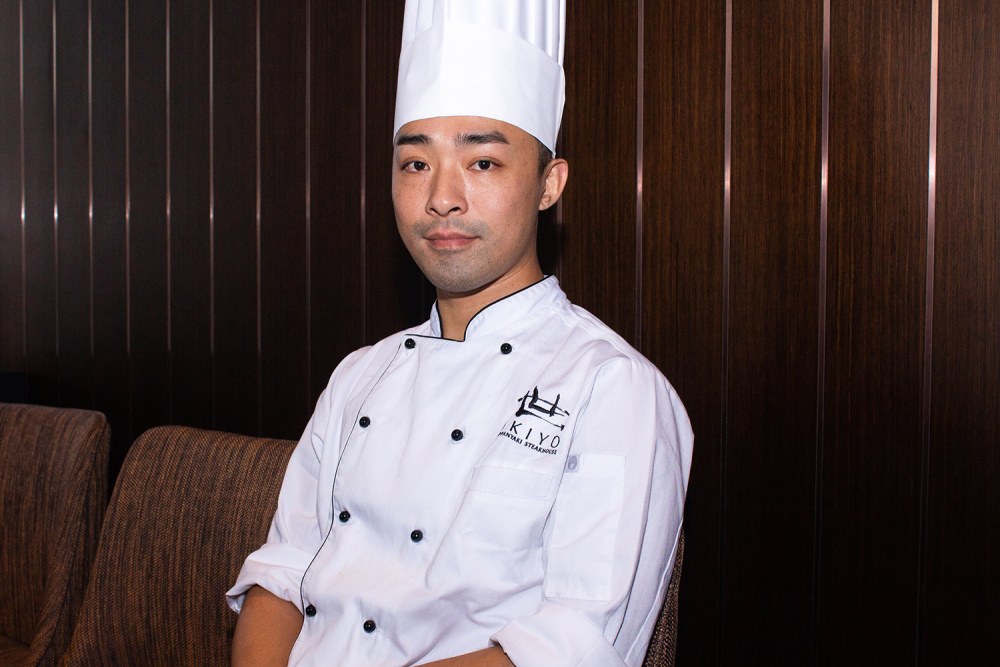
After our meal, we sat down with Executive Chef Arthur Li to learn more about this new restaurant and what we can expect from it in the coming months.
What’s your background?
I started learning teppanyaki around 2002 at Arima Teppanyaki in Causeway Bay. I then gained more experience at Chitose in SOGO and spent four years at the Sheraton hotel. After that, I helped to open Inakaya at ICC. I served as Inakaya’s teppanyaki chef for four years, and finally, I opened my own restaurant in Central.
What sets UKIYO apart from other teppanyaki restaurants?
Our restaurant isn’t that big, so we focus on our service and our ingredients – how good we are, how well we serve our customers and what we serve them, like our beef, which we dry-age in-house. We want to provide them with something different, something they can’t have elsewhere in Hong Kong.
It seems like Japanese diners have begun to develop a taste for dry-aged meat. How do you think local diners in Hong Kong will adapt?
This aged style has gotten more popular in Japan these past two years, so it makes sense that Hong Kong diners are following this trend. But in Hong Kong, there aren’t too many people adopting this style yet. I think local diners will enjoy it a lot; they have already come across this style of aged beef in Western cuisine. What we are trying to do is incorporate Japanese cooking methods with dry-aged beef. It’ll take some time, but we will teach our customers about dry-aged meat and its flavours and textures. The smell is stronger, the texture’s more tender, the flavour is richer. For example, when we cook a Japanese A4 sirloin, it’s a bit more oily when it’s not aged, but after we age it, it becomes more dry and the taste of the beef is stronger. Local diners need time to understand the differences, and we will teach them that dry-aged beef has a place in Japanese cuisine.
Teppanyaki restaurants are usually quite loud, with a lot of action going on and big groups of diners coming to visit. Your restaurant is quite small. Do you think you are limiting your message and audience?
Actually, all of that is intentional: our goal is to not hurry our guests. We are not pushing them to leave, and we don’t want to rush them. We don’t want high turnovers; our owner has made it clear that we don’t need that. We just want our clients to enjoy their meal. We’ve got time, and we’re charging a fair price for it. I’m training our staff to provide service from the heart. We need to care more, and we want our customers to enjoy their night here, with quality food and service.
What is the inspiration behind the menu?
It’s not entirely traditional, but I’m trying to do something more beautiful. Most teppanyaki restaurants just cook the dish and serve it immediately, but I want to provide more decoration, more colours, more flowers; we want to build the dish into something to look at. Nowadays, more young people can afford to eat more expensive foods, and they all go in with their phones first, so we’ll cater to that as well. If it‘s not beautiful, who will come? Of course, we balance all dishes between beautiful flavours and beautiful appearances.
What can we expect on the new menu?
I’ve been working on sauces, which are French inspired, and introducing more French and Spanish cooking styles. There’ll be more smoked beef, which I’ll smoke in front of guests. Even salads, we’ll make those in front of our customers. Most of the things that people do in the kitchen, we want to bring that in front of our diners. Our customers want to see the process, so we’ll show them.
What’s your favourite dish on the menu?
I don’t really have a special dish I like the most. But if you ask me which one is my strongest dish, I think it’s my fried rice. Old teppanyaki chefs, like my own teacher who is retired, they will tell you the simplest dish is the hardest to do. I’m lucky that I had a good teacher; he was part of the first round of chefs to learn how to cook teppanyaki in Hong Kong in the 60s, and I was his last student before he retired, about 15 years ago. The relationship between student and teacher back then was more like father and son, totally different to now. Nowadays, the young chefs come to a new job to be a student, but what they think is that it’s the head chef’s responsibility to teach them. What I had to do was to steal the teacher’s skill by watching only. We weren’t told; we had to watch and observe.
I can’t choose a favourite dish or one I like the most. If I did that, it would mean that I have stopped trying to do better, or more. Cooking never ends; skills are improved every day. Every day, I learn and think of new things.
Do you have a favourite ingredient?
Lobster, maybe. There are so many different ones; Boston, blue lobster, South China lobster, Japanese, Australian... and they’re all different textures. The one on the current menu is from the South China Sea; it’s the most suitable for teppanyaki. The Australian and Japanese ones are more suitable for sashimi, because of the texture; if it’s cooked, it will break. South China Sea lobsters are more firm, more tender and better suited for cooking.
We try to follow the seasons, because we serve seafood. In wintertime, the ingredients are more bountiful for Japanese cuisine. In other seasons, we don’t have as many options. Many people love crab, and we serve that in winter. In the summertime, we serve other things like oysters and eel. We’ve got a regular menu, but we also want to introduce a seasonal menu every three months and on special occasions like Valentine’s Day, Christmas and New Year’s.
What is one item on your menu that you would recommend the most?
The aged beef, of course! It’s not served in any other teppanyaki restaurant in Hong Kong.
18/F, Oliv, 15–21 Sharp Street East, Causeway Bay, 2152 8880
This write-up is based on a complimentary media tasting provided in exchange for an honest review and no monetary compensation. The opinions expressed here represent the author’s.
For more articles like this, like Foodie on Facebook











